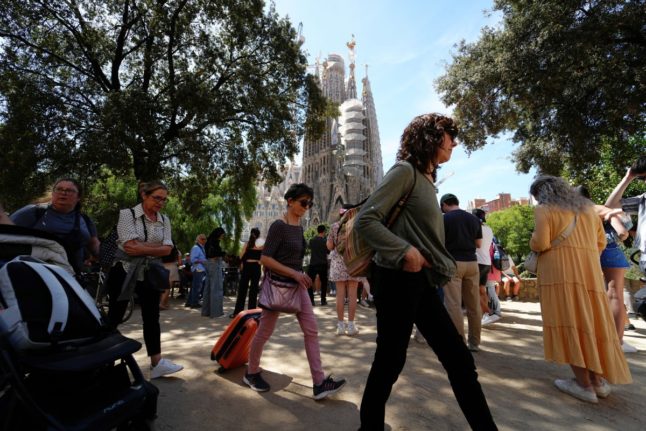Increasingly, regions across Spain have introduced restrictions for some of its most popular natural attractions, in a bid to stop overcrowding and promote sustainable tourism.
In the last twenty years, tourism in national parks has grown by 77 percent, with nearly 16 million annual visitors, according to a report by the Eco-union association.
Visitor numbers were at some of their highest during the Covid-19 pandemic, when both international and local tourists preferred to travel to natural areas, away from crowds in the big cities.
Increased tourist numbers cause a threat to natural habitats in the form of erosion, trampling of plant species, and frightening the local wildlife.
“Natural environments have to be protected against massive tourism that can degrade them, with regulations that allow their enjoyment, but also guarantee conservation,” explained the spokesperson for Ecologists in Action, Pau Monasterio.
Places that have a cap on visitor numbers include As Catedrais beach in Galicia, famed for its striking rock formations; Mount Teide, the highest mountain in Spain; and Doñana National Park, one of Europe’s most important wetlands.
Which regions have introduced restrictions?
Andalusia
Doñana National Park has been restricting visitors for several years. For example, only 886 people are allowed per day on the routes from Huelva to El Acebuche and El Rocío, as well as on the route along the river to Sanlúcar de Barrameda.
Aragón
Aragón’s Ordesa y Monte Perdido National Park has had visitor caps for years and intends to keep them in place.
Asturias
In Asturias, restrictions have been placed on numbers of tourists to the Covadonga Lakes, one of the most-visited areas of the Picos de Europa National Park. During the busiest times of the year, the lakes can only be accessed by bus or licensed taxi from the town of Cangas de Onís.
Balearic Islands
Home to 50 percent of the posidonia (seagrass) meadows in Spain, limitations in the Balearic Islands have been extended to the Marítimo-Terrestre de Cabrera National Park. Those who want to access the area by boat must request special permission.
This summer, the government of the Balearic Islands also hired environmental informants to travel around the beaches, spreading advice and information about the protected natural habitats of the islands.
Basque Country
After being bombarded by Game of Thrones fans because it was the filming location for Dragonstone, the islet of San Juan de Gaztelugatxe has finally reopened to the public, but with a daily limit of 1,500 people.
Canary Islands
With almost 15 million visitors per year, Mount Teide National Park on Tenerife is one of the most popular in Spain. Restrictions have been introduced on the last stretch of path up to the peak of Teide, allowing only 200 people per day.
Limits have also been introduced in Lanzarote’s Timanfaya National Park by making visitors pay for entry, while on La Gomera, the number of vehicles allowed to access the laurel forests has been capped.
In Gran Canaria, no-entry areas have been placed on Maspalomas beach, in order to protect the natural reserve of the dunes, while on Fuerteventura only a certain number per day can visit the tiny islet of Lobos.
Castilla-La Mancha
In Cuenca, limits on the numbers visiting the Chorreras del Cabriel waterfalls have been proposed. Experts have suggested that only 400 per day be allowed to visit the Biosphere Reserve, where this summer eleven bathers had to be rescued due to accidents.
Extremadura
In Extremadura, limits have been placed on access to various natural attractions including the Castañar Cave in Cáceres and the Fuentes de León Cave in Badajoz.
Galicia
The region of Galicia has restricted access to the famous Galician beach of As Catedrais by making people reserve a free ticket online in advance.
Madrid
In the capital region, it is only permitted to swim in specific natural areas including Los Villares in the San Juan Reservoir and the beaches of Alberche and Las Presillas in Rascafría. There are also limits on the number of people who can visit the popular green pools of La Charca Verde de la Pedriza, one of the most-visited areas of the Sierra de Guadarrama National Park.
Murcia
There are restrictions in Murcia on the number of private vehicles that can pass through the regional natural parks of Calblanque, Monte de las Cenizas and Peña del Águila.
Navarra
In Navarra, access to the source of the river Urederra, in the Urbasa Natural Park has been limited to a maximum of 500 per day, while at the reservoirs of Leurza and the Orgi forest, there are restrictions on the number of cars allowed.
Valencia
Valencia has restricted the number of cars that can access the Serra d’Irta Natural Park in summer. This stretch of road is situated alongside the d’Irta Marine Reserve. In Alicante, there is a cap on the number of tourists that can visit Peñón de Ifach in Calpe, as well as the cliffs of Cabo de San Antonio, within the protected area of the Montgó Natural Park.



 Please whitelist us to continue reading.
Please whitelist us to continue reading.
Member comments